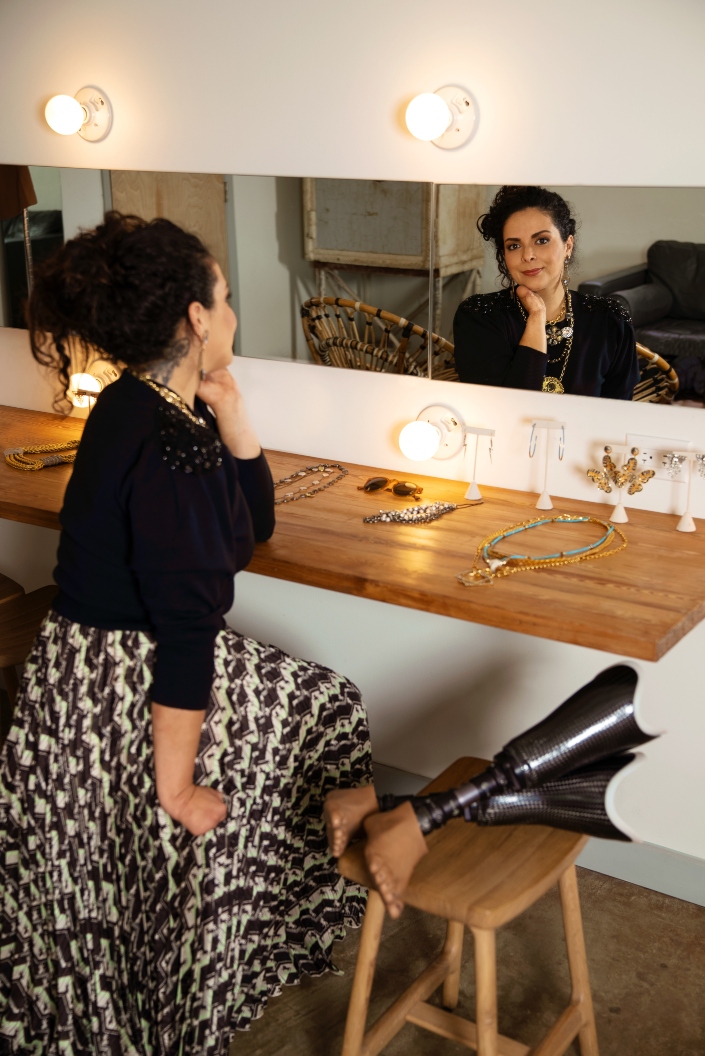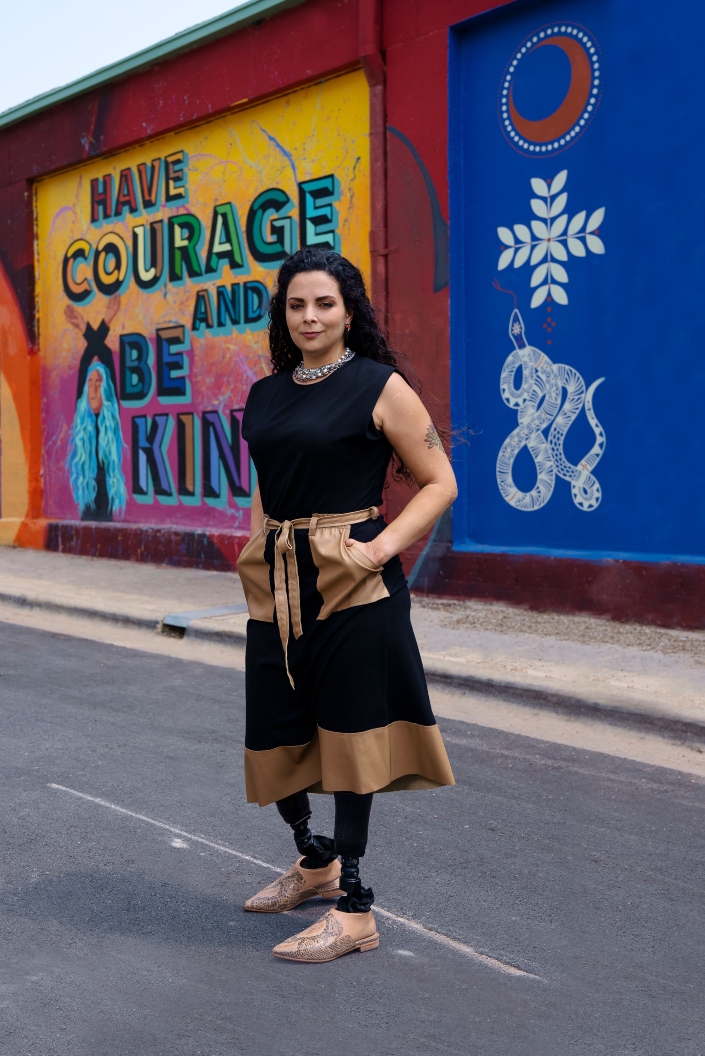Jamie Schanbaum has triumphed over an illness that took her limbs.

By Jenny Hoff, Photos by Romina Olson, Styled by Parke Ballantine with inspiration from Estilo, Makeup by Alicia Beller, Shot on location at Distribution Hall
Jamie Schanbaum has the kind of charming wit that can disarm even the most solemn conversationalist. She’s a person who notices all the absurdities of life and can’t keep the amusement at bay; a woman, who despite having confronted some of the most serious life situations just doesn’t take herself too seriously.
If attitude is everything, then Schanbaum—despite the loss of her legs and fingers—lacks absolutely nothing.
“I never felt like giving up those months that I was in the hospital,” says Schanbaum as she relaxes on her couch in her South Austin home, flanked by her cute and curious Great Pyrenees mix dog, Billie Jean (they both have birthdays this month), and her husband, Chris. “I was just looking ahead.”
Looking ahead was all Schanbaum could do after her whole world changed one innocuous Wednesday night in November 2008. A healthy and active 20-year-old college student at the University of Texas, studying for a career in pharmaceutical sales, Schanbaum was at a friend’s apartment doing laundry when she suddenly felt very fatigued. So fatigued she had to lay down on her friend’s couch to take a nap.
Schanbaum hadn’t really ever heard of meningitis or its heightened risk for college kids due to their close proximity to each other and lifestyles of high stress, questionable nutrition and lack of sleep. She didn’t know about a vaccine for it or the fact that bills had been introduced and killed in the Texas Legislature that would mandate it for incoming college students. Schanbaum just felt exhausted and thought she was coming down with the flu. But within 24 hours, her fatigue turned into vomiting and muscle weakness. She didn’t have a rash or stiff neck, some of the telltale signs of meningitis. But she did feel extreme sensitivity in her feet and hands.
“I couldn’t even walk; it was extremely painful and heavy,” recalls Schanbaum. “I stopped going to the kitchen fridge for water because the sink was closer. I was counting down the steps.”
Those were some of the last steps she would ever take on the legs she was born with.
Moving Forward
Schanbaum’s story of resilience doesn’t start with that fateful day in 2008, when she arrived at the hospital with her sister, unable to walk, freezing cold and begging for injections of hot water in her veins just so she could warm up. It didn’t begin the day she was transferred to Houston for two months of hyperbaric oxygen therapy, where she sat in a tube of pure oxygen for one hour every day, trying to save what she could of her limbs. It didn’t even begin the day her dead body parts were finally removed and she would begin a new life on prosthetic legs.
Schanbaum’s story of resilience begins when she was 3 months old. The youngest of four children, freshly entering the world at the same moment her father was leaving it.
“It kind of makes sense the way my siblings and I came out the way we did,” says Schanbaum. “My starting point was a rough one, I guess. As many Disney movies as I could watch, I knew that’s not how life really was.”

Schanbaum grew up watching her mom, Patsy Schanbaum, raise her and her siblings alone, after Jamie’s father passed away from cancer just months after her birth. Left with four children under the age of 6, Patsy had to make the decision to either throw in the towel and bemoan her fate or pick up and move on, raising her kids with as much humor and fortitude as possible. She chose the latter. And unknowingly instilled in her young daughter a kind of strength and life philosophy she would one day desperately need in order to survive.
“It’s the journey that you’re on,” says Patsy. “If you fight it, then it can be heavy on your heart, spirit and soul. You have to accept that this is the life that you’ve been given.”
Schanbaum has more than accepted the life she has been given; she’s bulldozing her way forward, accomplishing every dream she has. Some with modifications, others more ambitious than she may have ever considered before she got sick. “You always hear people say, ‘Make something out of your life, make a change,’” she says. “I’m like, ‘I feel good. I already did that.’ My goal is to make sure the whole country is protected against meningitis.”
Not long after Schanbaum left the hospital, she and her mom got to work convincing state legislators to pass legislation mandating the meningitis vaccine for college students in Texas. In the summer of 2009, Senate Bill 819, known as the Jamie Schanbaum Act, passed the Texas Legislature and was signed into law by Governor Rick Perry. Schanbaum became a spokesperson for GSK, a research and development company that produces vaccines, and she has given speeches around the country educating the public on the dangers of meningitis. Her family created a 501(c)(3) nonprofit organization, the J.A.M.I.E. Group, which stands for Joint Advocacy of Meningococcal Information & Education. Their goal is to prevent meningitis from stealing any more lives—or limbs.
“I quickly went from ‘Why did this happen to me?’ to ‘Why does this keep happening to others?’” explains Schanbaum. “There is a way to prevent this from happening. My friend didn’t get sick, even though I was barfing all over her house. That’s because she was vaccinated.”
Schanbaum is now out to educate the whole country on not just the original meningitis vaccine, which protects against strains A, C, W and Y, but also the newest vaccine that was created in 2014, which protects against the B strain. The campaign Ask2BSure encourages parents and adolescents to ask their doctors about getting both vaccines so they are protected against all five strains of meningitis.
Rebirth
After two days in the hospital, Schanbaum was finally diagnosed with Meningococcal septicemia, the C strain, a rare and more deadly form of meningitis that infects the blood, rather than the brain and spinal cord. She was put into a medically induced coma as doctors tried to get her heart rate down. At one point, she was given only a 20% chance of survival. Three weeks later, when she was brought out of the coma, Schanbaum witnessed her legs and fingers turn from red to purple to black as her body struggled to protect her organs by sacrificing her extremities.
Three months after she first fell ill, Schanbaum decided to stop trying to save her limbs and go ahead with the needed amputations. Both to avoid sepsis, another poisoning of the blood, and to move on with her life. She was ready to go back to college and begin again. Schanbaum considers that day in February her second birth.

“Watching my body decay before my eyes, I was just like, ‘Whatever, you guys, I’m thinking about exams,’” Schanbaum says with a wry smile. “It didn’t really set in until I left the hospital. I was a social stigma: I was in a wheelchair. I wasn’t thrilled with people staring at me all the time.”
Her mom recounts a time when a little boy asked Schanbaum what had happened to her. Schanbaum responded, with a deadpan face, “When they tell you don’t feed the bears, don’t feed the bears.”
Patsy laughs at the memory, explaining that the child was a relative who enjoyed the tall tale. “Another time, a man at the airport asked us what war she had fought in,” she recounts. “I told him she was never in the military, but she did fight a war.”
While Schanbaum likes to lighten the mood when talking about her story, she’ll be the first to admit it was a long road to get where she is today. Her older brother, Nicholas, a lawyer based in Dallas who dropped everything 13 years ago when his sister got sick and stayed by her side in the hospital, says he and his family used a lot of tough love to keep her going through some of the more painful periods.
“It’s one thing to overcome adversity, and it’s another thing to relearn to walk and constantly get skin grafts; it’s exhausting,” says Nicholas. “Not like running a marathon. In a marathon, you can take breaks. All of it can be draining. We would remind her, ‘You’re doing great, you’re going to keep doing great. So suck it up.’”
It took one year from when Schanbaum entered the hospital to when she could finally, with the help of her new legs, take a few steps on her own. Deciding to go ahead with the amputations and start her new life was one thing; learning to function with her new body was another. She credits her occupational therapist, Bob Whitford, with helping her believe she could accomplish the seemingly impossible.
“It took some convincing,” she laughs, recalling when Whitford first mentioned she should try bicycling again, an activity she had enjoyed before her sickness. “The first time he said it, I was 80 pounds, a fresh amputee and had barely any hair on my head. I was like, ‘Can this guy get out of my room?’”
But Whitford happens to be especially qualified as both an occupational therapist and a promoter of beating the odds. He was 4 ½ years old when he lost his right arm in a hayride accident while living in Springfield, Missouri. Today, he rides a motorcycle to and from work. Whitford played tennis throughout high school. He ranked fifth in cycling in the 1996 Atlanta Paralympic games and won the bronze medal in Sydney in 2000. He considers his profession much more than a job, but a calling. His clients aren’t just patients, but family. They’re starting a new life. They need a different kind of support system, someone who can help show them the way.
“I frequently say to my patients, ‘There is a time when you can, and there is a time when you cannot,’” says Whitford. “If you appreciate the times when you can, then you won’t have regrets in the time that you cannot.”
The first time he mentioned getting on a bike to Schanbaum he knew she wasn’t ready. But he was planting a seed. Painting a different picture for her future. Months into her therapy, he brought her an adapted tricycle and sat her on it, letting her experience the sensation of riding again. He calls that moment the germination of the seed, a chance to show her what could blossom. After several more months of hard work, exercise and practicing on a stationary bike, she was ready to bloom.
“We went out to the Veloway, and she was a natural,” recalls Whitford. “She loved riding a bicycle before her injury, so that was her liberation.”
Three years after entering the hospital and one year after getting on a bike again, Schanbaum was trying out for the USA Paralympics cycling team, winning a gold medal in her division in the road nationals in Augusta, Georgia, and competing in the 2011 Pan American Games in Guadalajara, Mexico.
“You can choose your path,” says Whitford. “You can choose to take it on as a challenge or curl up and resign. She chose to take on the challenge of life.”
He’s proud of helping her get back on the road. But, he says, Schanbaum impacted his life as much as he has hers. He just sent his two daughters to the University of Texas. They first met Schanbaum 13 years ago, when they were little girls and their father was helping her regain her mobility.
“I said to them recently, ‘You know the reason you have to get a vaccine for meningitis before going to college is because of Schanbaum.’ Life comes full circle, doesn’t it?”
Champion Moment

Schanbaum’s accomplishments would be impressive for someone with no adversity or disability, let alone for someone who nearly lost her life and did lose her legs and fingers at just 20 years old. Schanbaum is proud of her cycling achievements, her work with grassroots organizations and celebrities to spread awareness and get legislation passed, her ability to complete her education and now work a full-time job. But what she considers her greatest victory is a milestone that even with her optimistic spirit and can-do attitude she sometimes doubted would ever happen.
“My biggest champion moment is getting married,” she says, smiling at her husband sitting next to her. “That could have all been taken away for sure. Thinking about being disabled and meeting people—I didn’t know what it would be like.”
Schanbaum’s love story is simple, yet shimmers with serendipity. After her illness she went on a few dates but never felt any spark. Online dating hadn’t really caught on yet, though she says posting pictures of herself with her disability “would have filtered out the losers really quickly.”
While she enjoys traveling and speaking about meningitis publicly, in personal conversations she prefers to hear other people’s life stories rather than always rehashing her own.
It turned out the spark she finally felt was with someone she didn’t have to explain her life to, because he had already been in it for many years.
“Our best friends were siblings, and anytime I would go to my friend’s house he was there,” explains Schanbaum. “We knew each other in high school but didn’t really talk. One day, ten years ago, I went to meet up with my friend in Wimberly, and he was there. We were all hanging out and [Chris and I] started to look at each other differently than before.”
In 2017, after spending three years in a long-distance relationship when he was stationed with the Army in Hawaii, and dating for six years altogether, she and Chris got married in Wimberly where their love story began. They plan to start trying for children sometime in the near future.
“We’re almost in the exact place where we want to be to start having kids,” Schanbaum wrote in an e-mail correspondence. “The earliest we think we’ll start trying is by summer time next year. Eek! Ahh! Maybe another year after that.”
Schanbaum’s life nowadays is a blissfully ordinary one—a husband, a dog, a job in sales. Having had enough pharmaceuticals to last a lifetime, Schanbaum switched her major and received a degree in human development and family sciences instead. She’s passionate about connecting with people, educating them and being a part of their lives. Perhaps even saving some of them the heartache that her own family members and families of those who didn’t survive meningitis have gone through. Of course, she faces everyday obstacles that most people never even consider. Opening doors, putting on her legs every morning, asking her husband to put on her earrings. But she’s not complaining. Her life is full, her life has meaning and she doesn’t take a day of it for granted.
“If smiling eyes was a person, it would be Jamie,” Nicholas says, gushing about his little sister. “She’s a very bold and confident woman. Confident despite having every reason to tuck tail and run. That’s powerful.”
Meningitis Facts:
- An estimated 1 in 10 people have the bacteria for meningitis in their throat and nose. A sudden illness can permit the bacteria to enter the bloodstream.
- Data shows 800 to 1200 people in the U.S. contract meningitis each year.
- Meningitis is most prevalent in infants and young adults.
- For those who contract meningitis, an estimated 1 in 10 will die. 1 in 5 will live with disabilities, including loss of limbs, nerve damage and hearing loss.
- For more information on the vaccines available, including the newer “Men B” vaccine, visit ask2bsure.com.


